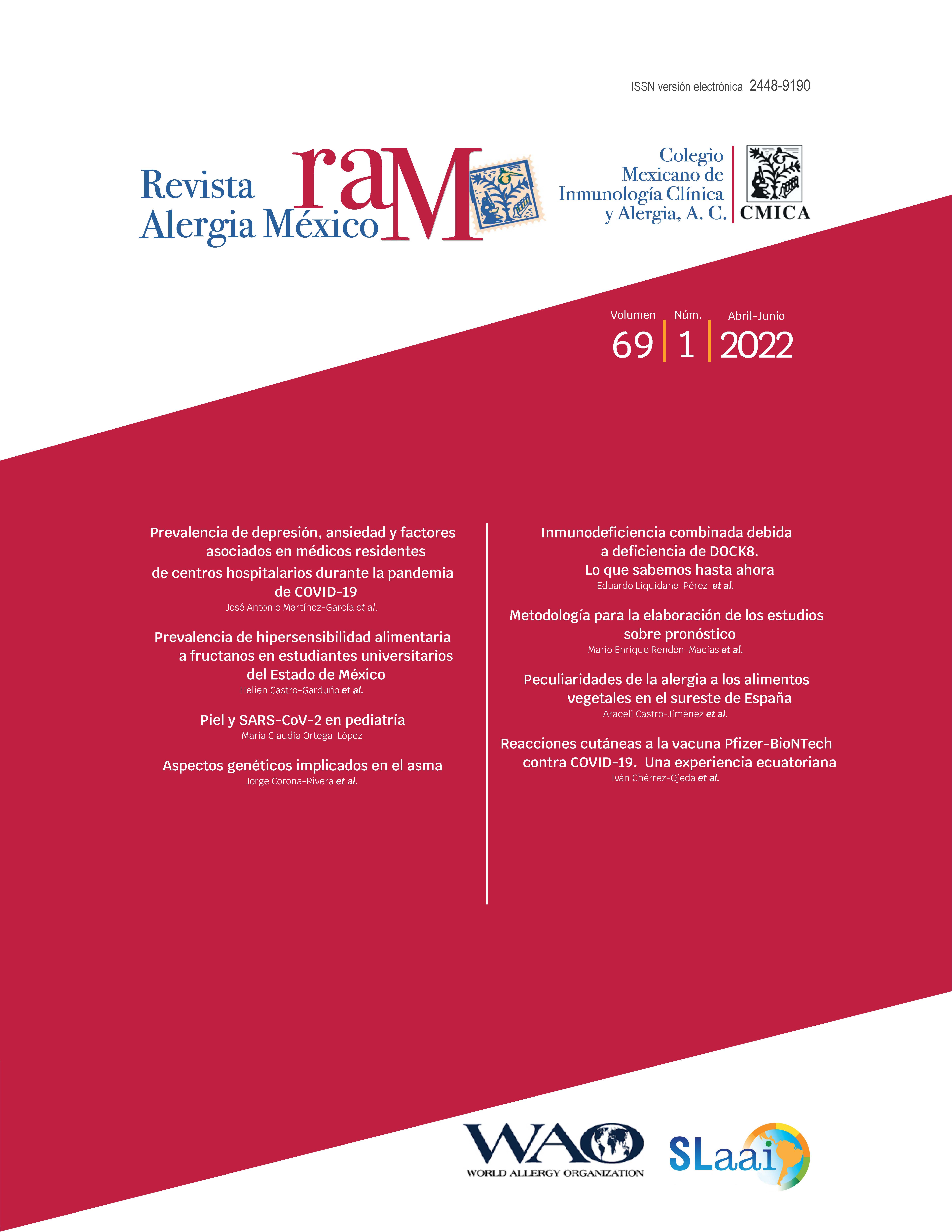Abstract
Background: Fructans are fructose polymers, the most common are inulin, fructo-oligosaccharides and levano. They cannot be hydrolyzed by human alimentary enzymes. Fructans food hypersensitivity (FFH) refers to the appearance of symptoms secondaries to the consumption of food with a high content of these carbohydrates.
Objective: To determine the self-reported prevalence of fructans food hypersensitivity in a sample of Mexican university students and to investigate the most frequent symptoms, the related foods involved, risk factors and gastrointestinal function status.
Methods: A cross-sectional, descriptive study was conducted in a convenience sample of 412 university students aged from 18 to 35 years. Data were collected about their personal and family history of gastrointestinal diseases, the presence of symptoms after consumption of certain foods, and the severity of their symptoms.
Results: The prevalence of FFH was 31.1 %; it was higher in women than in men. The most frequent gastrointestinal symptoms were bloating and flatulence. The most frequent extra-intestinal symptoms were fatigue and stress. The food groups related to the occurrence of symptoms were legumes, vegetables and fruits. Significant association was found between female sex, personal and family history of gastrointestinal diseases and the presence of FFH (p < 0.05). The majority of individuals with FFH had mild gastrointestinal dysfunction (67.2%).
Conclusion: FFH is a common condition, it was found in one third of university students and occurs mainly in women. More research and diffusion about this pathology is required.
References
Tuck CJ, Biesiekierski JR, Schmid-Grendelmeier P, Pohl D. Food intolerances. Nutrients. 2019;11(7):1684. DOI: 10.3390/nu11071684
Puente-Fernández C, Maya-Hernández RL, Flores-Merino MV, Romero-Figueroa MS, Bedolla-Barajas M, Domínguez-García MV. Self-reported prevalence and risk factors associated with food hypersensitivity in Mexican young adults. Ann Allergy Asthma Immunol. 2016;116(6):523-527. DOI: 10.1016/j.anai.2016.03.010
Ruiz-Sánchez JG, Palma-Milla S, Pelegrina-Cortés B, López-Plaza B, Bermejo-López LM, Gómez-Candela C. Una visión global de las reacciones adversas a alimentos: alergia e intolerancia alimentaria. Nutr Hosp. 2018;35(4):102-108. DOI: 10.20960/nh.2134
Muthukumar J, Selvasekaran P, Lokanadham M, Chidambaram R. Food and food products associated with food allergy and food intolerance – An overview. Food Res Int. 2020;138(Pt B):109780. DOI: 10.1016/j.foodres.2020.109780
World Health Organization. White book on allergy. EE. UU.: 2011. Disponible en: https://www.worldallergy.org/UserFiles/file/WAOWhite-Book-on-Allergy_web.pdf
De Martinis M, Sirufo MM, Suppa M, Ginaldi L. New perspectives in food allergy. Int J Mol Sci. 2020;21(4):1-21. DOI: 10.3390/ijms21041474
Chumpitazi BP, McMeans AR, Vaughan A, Ali A, Orlando S, Elsaadi A, et al. Fructans exacerbate symptoms in a subset of children with irritable bowel syndrome. Clin Gastroenterol Hepatol. 2018;16(2):219-225. DOI: 10.1016/j.cgh.2017.09.043
Ortiz-Soto ME, Porras-Domínguez JR, Seibel J, López-Munguía ALM. A close look at the structural features and reaction conditions that modulate the synthesis of low and high molecular weight fructans by levansucrases. Carbohydr Polym. 2019;219:130-142. DOI: 10.1016/j.carbpol.2019.05.014
Sanders ME, Merenstein DJ, Reid G, Gibson GR, Rastall RA. Probiotics and prebiotics in intestinal health and disease: from biology to the clinic. Nat Rev Gastroenterol Hepatol. 2019;16(10):605-616. DOI: 10.1038/s41575-019-0173-3
Geysen H, Gielis E, Deloose E, Vanuytsel T, Tack J, Biesiekierski J, et al. Acute administration of fructans increases the number of transient lower esophageal sphincter relaxations in healthy volunteers. Neurogastroenterol Motil. 2020;32(1):1-7. DOI: 10.1111/nmo.13727
Zhou SY, Gillilland M, Wu X, Leelasinjaroen P, Zhang G, Zhou H, et al. FODMAP diet modulates visceral nociception by lipopolysaccharidemediated intestinal inflammation and barrier dysfunction. J Clin Invest. 2018;128(1):267-280. DOI: 10.1172/JCI92390
Dinan TG, Cryan JF. Brain-gut-microbiota axis and mental health. Psychosom Med. 2017;79(8):920-926. DOI: 10.1097/PSY.0000000000000519
Beltrán YL, Guadarrama R, Arzate G, Flores MV, Jaimes AE, Reyes DY, Domínguez MV. Construcción y validación de un cuestionario para medir función gastrointestinal en adultos. Nutr Clin Diet Hosp. 2020;40(3):26-35.
Chong L. Should you avoid eating fructans? EE. UU.: The Ohio State University/Wexner Medical Center; 2021. Disponible en: https://wexnermedical.osu.edu/blog/should-you-be-avoiding-fructans
Lee HJ, Kim HJ, Kang EH, Jung KW, Myung S-J, Min YW, et al. Selfreported food intolerance in Korean patients with irritable bowel syndrome. J Neurogastroenterol Motil. 2019;25(2):222-232. DOI: 10.5056/jnm18125
Böhn L, Störsrud S, Törnblom H, Bengtsson U, Simrén M. Self-reported food-related gastrointestinal symptoms in IBS are common and associated with more severe symptoms and reduced quality of life. Am J Gastroenterol. 2013;108(5):634-641. DOI: 10.1038/ajg.2013.105
Berg LK, Fagerli E, Myhre AO, Florholmen J, Goll R. Self-reported dietary fructose intolerance in irritable bowel syndrome: proposed diagnostic criteria. World J Gastroenterol. 2015;21(18):5677-5684. DOI: 10.3748/wjg.v21.i18.5677
Van Gils T, Nijeboer P, Ijssennagger CE, Sanders DS, Mulder CJJ, Bouma G. Prevalence and characterization of self-reported gluten sensitivity in The Netherlands. Nutrients. 2016;8(11):1-9. DOI: 10.3390/nu8110714
Kamran H, Imtiaz A, Amin F, Ghazzanfar SS, Sani S, Fatima S, et al. Impact of food intolerance on quality of life among university students. J Psychol Clin Psychiatry. 2020;11(2):60-64. Disponible en: https://medcraveonline.com/JPCPY/JPCPY-11-00672.pdf
Afify SM, Pali-Schöll I. Adverse reactions to food: the female dominance. A secondary publication and update. World Allergy Organ J. 2017;10(1):43. DOI: 10.1186/s40413-017-0174-z
Masuy I, van Oudenhove L, Tack J, Biesiekierski JR. Effect of intragastric FODMAP infusion on upper gastrointestinal motility, gastrointestinal, and psychological symptoms in irritable bowel syndrome vs healthy controls. Neurogastroenterol Motil. 2018;30(1):1-12. DOI: 10.1111/nmo.1316722.
Cox SR, Prince AC, Myers CE, Irving PM, Lindsay JO, Lomer MC, et al. Fermentable carbohydrates [FODMAPs] exacerbate functional gastrointestinal symptoms in patients with inflammatory bowel disease: a randomised, double-blind, placebo-controlled, cross-over, re-challenge trial. J Crohn’s Colitis. 2017;11(12):1420-1429. DOI: 10.1093/ecco-jcc/jjx07323.
Skodje GI, Sarna VK, Minelle IH, Rolfsen K, Muir JG, Gibson PR, et al. Fructan, rather than gluten, induces symptoms in patients with self-reported non-celiac gluten sensitivity. Gastroenterology. 2018;154(3):529-539. DOI: 10.1053/j.gastro.2017.10.040
Cárdenas-Torres FI, Cabrera-Chávez F, Figueroa-Salcido OG, Ontiveros N. Non-celiac gluten sensitivity: An update. Medicina (Kaunas). 2021;57(6):526. DOI: 10.3390/medicina5706052625.
Catassi C, Alaedini A, Bojarski C, Bonaz B, Bouma G, Carroccio A, et al. The overlapping area of non-celiac gluten sensitivity (NCGS) and wheat-sensitive irritable bowel syndrome (IBS): an update. Nutrients. 2017;9(11):1268. DOI: 10.3390/nu911126826.
Pryor J, Burns GL, Duncanson K, Horvat JC, Walker MM, Talley NJ, et al. Functional dyspepsia and food: immune overlap with food sensitivity disorders. Curr Gastroenterol Rep. 2020;22(10):51. DOI: 10.1007/s11894-020-00789-9.

This work is licensed under a Creative Commons Attribution-NonCommercial 4.0 International License.
Copyright (c) 2022 Revista Alergia México





